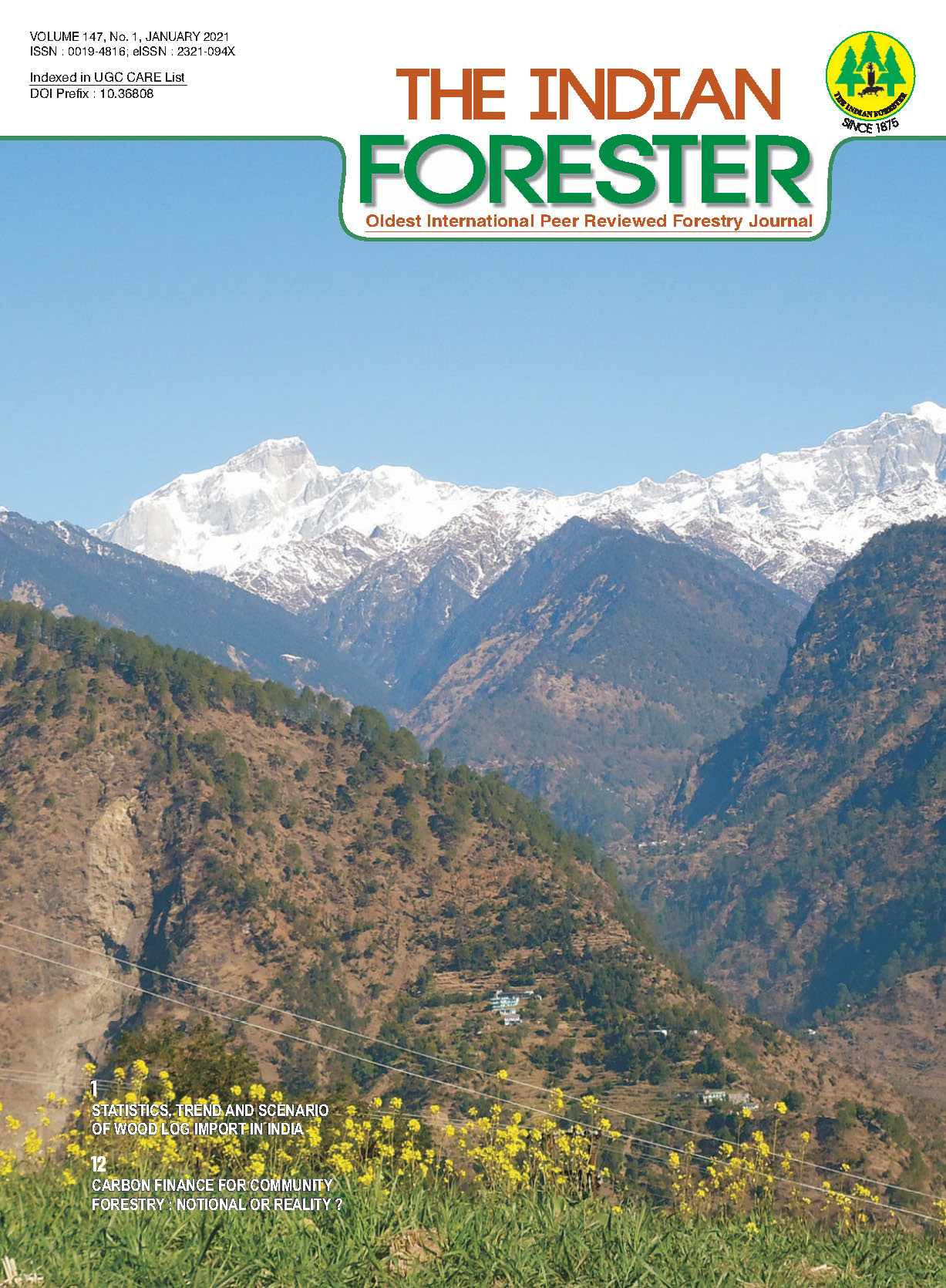New Record of Selepa celtis Moore (Lepidoptera: Nolidae) as Fruit pest of Indian Rudraksha Tree
DOI:
https://doi.org/10.36808/if/2021/v147i1/156179Keywords:
noneAbstract
No Abstract.References
Bajpai R. (2004). Seasonal incidence of Selepa celtis on aonla at Jabalpur. Indian Journal of Agroforestry, Vol. 6(1): 95-96.
Beeson C.F.C. (1941). The ecology and control of the forest insect pests of India and the neighbouring countries. Vasant Press, Dehradun. 767 pp.
Bharpoda T.M., Koshiya D.J. and Korat D.M. (2009). Seasonal occurrence of insect-pests on aonla (Emblica officinalis Geartn) and their natural enemies. Karnataka J. Agric. Sci., 22(2): 314-318.
Bhuyan P. (2002). Ecological studies on seed production, dispersal, germination and seedling fitness of Rudraksh (Elaeocarpus ganitrus Roxb.). Ph. D Thesis, Department of Botany, North-Eastern Hill University, Shillong, Meghalaya, India.
Browne F.G. (1968). Pests and diseases of forest plantation trees. Clarendon Press, Oxford. 1330 pp.
Haldhar S.M., Chetram and Singh D. (2019). Biotic stress (insect) of Aonla (E. officinalis) in arid region of India. J. of Agric. And Ecology, 7, pp. 16-26.
Haldhar S.M., Deshwal S.H., Jat G.C., Berwal M.K. and Singh D. (2016a). Pest scenario of ber (Ziziphus mauritiana) in arid region of Rajasthan: a review. J. of Agric. & Ecology, 1, pp.10-21.
Hardainiyan S. Nandi B.C. and Kumar K. (2015). Elaeocarpus ganitrus (Rudraksha): a reservoir plant with their pharmacological effects. Int. J. Pharm Sci. Rev. Res., 34(1): 55-64.
Joshi K.C. and Meshram P.B. (1989). A new report of Selepa celtis Moore (Lepidoptera:Noctuidae) as a pest of babul (Acacia nilotica) and Aonla (Emblica Officinalis). The Indian Forester, 115 (11):847.
Joshi S.C. and Jain P.K. (2014). A review on ethnomedicinal and traditional uses of Elaeocarpus ganitrus Rox. (Rudraksha). Int. J. Pharm. Bio. Sci., 5(1): 495-511.
Khan H.R., Prasad L. and Kumar S. (1985). Some important forest insect pests of Madhya Pradesh and their control. Presented in Forestry Conference, MP, SFRI, Jabalpur, during 18-20 Feb., 1985.
Khan M.L.; Bhuyan P. and Tripathi R.S. (2003). Regeneration of Rudraksha (Elaeocarpus ganitrus) – a threatened tree species: Germination strategies. International Journal of Ecology and Environmental Science, 29: 255-260.
Khan M.L.; Bhuyan P. and Tripathi R.S. (2004). Survival and growth of seedlings of Rudraksh (Elaeocarpus ganitrus) under varied canopy conditions after transplant. Tropical Ecology, 45(2): 233-239.
Mathur R.N. and Singh B. (1959). A list of insect pests of forest plants in India and the adjacent countries. Part 5- list of insect pests of plant genera “D to Fâ€. Indian Forest Bulletin No. 171(4): 68.
Murty S.K. (1993a). Elaeocarpaceae. In. Flora of India, 3: 528-573. Rao R.R. and Haridasan K. (1983). Threatened plants of
Meghalaya – a plea for conservation. In: An Assessment of Threatened Plants of India (eds Jain, S. K. and Rao, R. R.), Botanical Survey of India, Howrah, pp. 94–103.
Seetha K.N. (2005). Power of Rudraksha, Jaico Publishing House, Delhi, India.
Shah R.H. (1996). Bionomics and control of Aonla hairy caterpillar, S. celtis Moore. MSc. Thesis, Dept. of Agricultural Entomology, B. A. College of Agriculture, Gujrat Agricultural University, Anand.
Singh A.N. (2018). Recent trends in import and export of Rudraksha beads in India. Journal of Non Timber Forest products, 25(4): 127-130.
Singh R., Sasidharan K.R., Rajarishi R. and Salarkhan A.M. (1997). Biology and feeding behavior of Selepa celtis Moore (Lepidoptera:Noctuidae) on Acacia nilotica spp. Indica. Indian Journal of Forestry, 20 (2): 134-164.
Tilak A., Gangwar S.S., Thakur R.N. and Sharma R. (2017). Elaeocarpus ganitrus (Rudraksha) medicinal use in modern time. Imp. J. Interdisc. Res., 3(1): 1531-1538.
Verma R.K. and Meshram P.B. (2018). Biotic factors responsible for damage of Khamer (Gmelina arborea) plantation in Central India. The Indian Forester, 144(11): 1063-1071.
Downloads
Downloads
Published
How to Cite
Issue
Section
License
Unless otherwise stated, copyright or similar rights in all materials presented on the site, including graphical images, are owned by Indian Forester.





